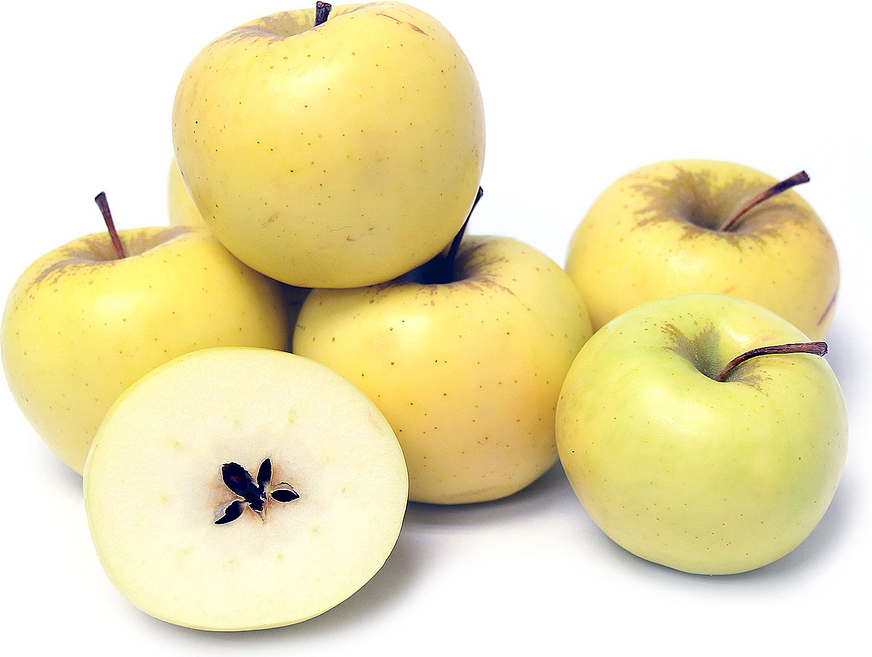


Silken Apples
Estimated Inventory, lb : 0
Description/Taste
Silken apples are moderately sized, round to oval fruits with a symmetrical, uniform appearance. The skin is smooth, waxy, delicate, and has a yellow-green base, sometimes splashed with light pink blush on the side most exposed to the sun. There is also some brown russeting surrounding the slender and fibrous stem. Underneath the thin skin, the flesh is crisp, white to ivory, aqueous, and aromatic, encasing a central core filled with small, black-brown seeds. Silken apples are crunchy and have a balanced, sweet-tart, honeyed flavor with moderate acidity.
Seasons/Availability
Silken apples are available for a short season in the early fall.
Current Facts
Silken apples, botanically classified as Malus domestica, are an early to mid-season variety that belongs to the Rosaceae family. The cultivar was first developed in Canada from a cross between the honeygold and sunrise apple varieties and was selected for its crisp texture, sweet flavor, and unusual pale coloring. Silken apples are not commercially cultivated due to their short storage capabilities and thin, easily damaged skin. The sweet apples are considered to be a dessert cultivar and are primarily grown through specialty orchards as a fresh-eating apple.
Nutritional Value
Silken apples are a good source of fiber, which has been shown to help regulate the digestive tract and contains potassium, which is a mineral that can balance fluid levels in the body. The apples also provide vitamin C and flavonoids, which have anti-inflammatory and antioxidant properties.
Applications
Silken apples are best suited for raw applications as their sweet, honeyed flavor is showcased when consumed fresh, out-of-hand. The apples can be sliced and served on appetizer plates with nuts, cheeses, and dips, chopped into green and fruit salads, or dipped whole into caramel as a sweet dessert. Silken apples can also be utilized in cooked applications and can be blended into applesauce, pressed into juices and ciders, sliced and served with roasted meats, or roughly chopped and cooked into stuffing. In addition to savory dishes, the apples are sometimes used for their sweet flavor in baked goods such as tarts, turnovers, muffins, biscuits, and cobblers. Silken apples pair well with honey, vanilla, maple syrup, ginger, mint, meats such as pork chop, bacon, or sausage, seafood, cheddar, figs, rainbow chard, potatoes, dried cranberries, and raisins. The fresh apples will keep 4-6 weeks when stored whole and unwashed in the crisper drawer of the refrigerator.
Ethnic/Cultural Info
Silken apples are often featured at the annual Apple Festival held at the University of British Columbia’s Botanical Garden. This two-day event generally occurs in the fall and is the garden’s largest fundraising event, attracting over 15,000 visitors. During the event, visitors can learn about many new, conventional, and heritage varieties and sample over forty different cultivars that are being grown in British Columbia. It has been reported that approximately 50,000 pounds of apples are also available for purchase during the event, allowing visitors the opportunity to take home their favorite varieties. In addition to introducing attendees to new apples, the Apple Festival also hosts many educational talks with apple experts and has live performances, contests, and vendors selling sweets, consumer goods, and apple dishes. One contest even features home gardeners attempting to stump a panel of experts with their home-grown apple variety.
Geography/History
Silken apples were developed at the Pacific Agri-Food Research Centre in Summerland, British Columbia, in 1982. The variety was created from a cross between honeygold and sunrise apples, and it took breeders R.A. Macdonald and W.D. Lane over fourteen years to perfect the new cultivar. Silken apples were released to the market in 1999, and today the variety is primarily found through specialty growers at farmer’s markets and through online seed catalogs for home garden use.
Recipe Ideas
Recipes that include Silken Apples. One
| Two Peas and Their Pod |
|
Apple Zucchini Muffins |
| Kleinworth & Co |
|
Banana Apple Muffins |




